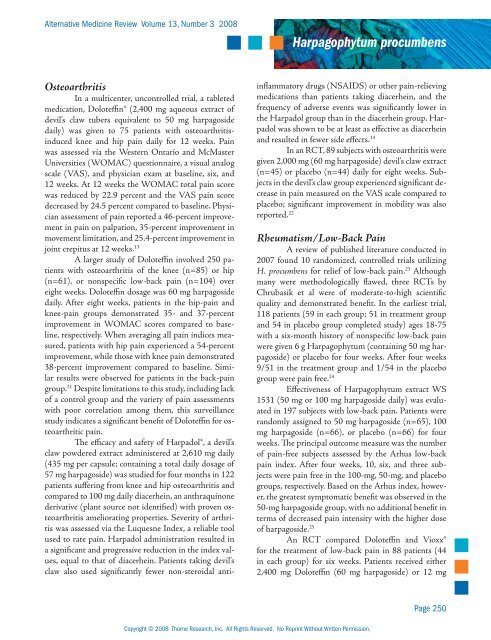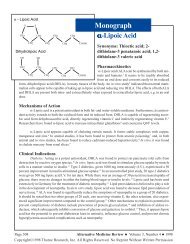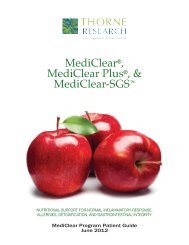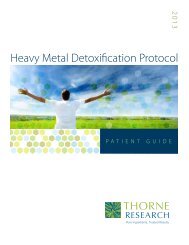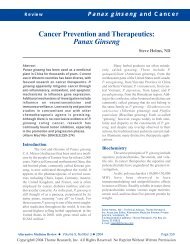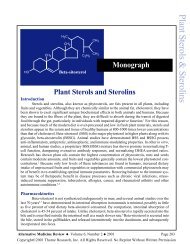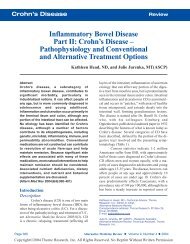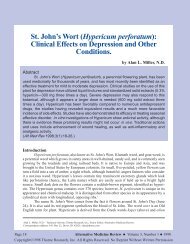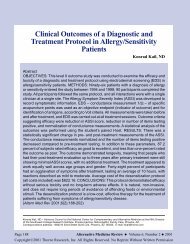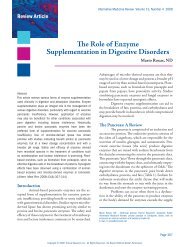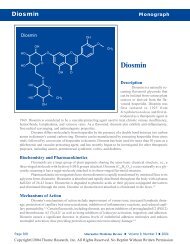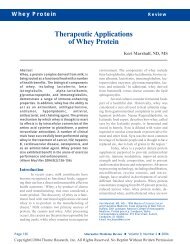Harpagophytum procumbens (Devil's Claw) - Thorne Research
Harpagophytum procumbens (Devil's Claw) - Thorne Research
Harpagophytum procumbens (Devil's Claw) - Thorne Research
- No tags were found...
Create successful ePaper yourself
Turn your PDF publications into a flip-book with our unique Google optimized e-Paper software.
Alternative Medicine Review Volume 13, Number 3 2008<strong>Harpagophytum</strong> <strong>procumbens</strong>OsteoarthritisIn a multicenter, uncontrolled trial, a tabletedmedication, Doloteffin® (2,400 mg aqueous extract ofdevil’s claw tubers equivalent to 50 mg harpagosidedaily) was given to 75 patients with osteoarthritisinducedknee and hip pain daily for 12 weeks. Painwas assessed via the Western Ontario and McMasterUniversities (WOMAC) questionnaire, a visual analogscale (VAS), and physician exam at baseline, six, and12 weeks. At 12 weeks the WOMAC total pain scorewas reduced by 22.9 percent and the VAS pain scoredecreased by 24.5 percent compared to baseline. Physicianassessment of pain reported a 46-percent improvementin pain on palpation, 35-percent improvement inmovement limitation, and 25.4-percent improvement injoint crepitus at 12 weeks. 13A larger study of Doloteffin involved 250 patientswith osteoarthritis of the knee (n=85) or hip(n=61), or nonspecific low-back pain (n=104) overeight weeks. Doloteffin dosage was 60 mg harpagosidedaily. After eight weeks, patients in the hip-pain andknee-pain groups demonstrated 35- and 37-percentimprovement in WOMAC scores compared to baseline,respectively. When averaging all pain indices measured,patients with hip pain experienced a 54-percentimprovement, while those with knee pain demonstrated38-percent improvement compared to baseline. Similarresults were observed for patients in the back-paingroup. 21 Despite limitations to this study, including lackof a control group and the variety of pain assessmentswith poor correlation among them, this surveillancestudy indicates a significant benefit of Doloteffin for osteoarthriticpain.The efficacy and safety of Harpadol®, a devil’sclaw powdered extract administered at 2,610 mg daily(435 mg per capsule; containing a total daily dosage of57 mg harpagoside) was studied for four months in 122patients suffering from knee and hip osteoarthritis andcompared to 100 mg daily diacerhein, an anthraquinonederivative (plant source not identified) with proven osteoarthritisameliorating properties. Severity of arthritiswas assessed via the Luquesne Index, a reliable toolused to rate pain. Harpadol administration resulted ina significant and progressive reduction in the index values,equal to that of diacerhein. Patients taking devil’sclaw also used significantly fewer non-steroidal antiinflammatorydrugs (NSAIDS) or other pain-relievingmedications than patients taking diacerhein, and thefrequency of adverse events was significantly lower inthe Harpadol group than in the diacerhein group. Harpadolwas shown to be at least as effective as diacerheinand resulted in fewer side effects. 14In an RCT, 89 subjects with osteoarthritis weregiven 2,000 mg (60 mg harpagoside) devil’s claw extract(n=45) or placebo (n=44) daily for eight weeks. Subjectsin the devil’s claw group experienced significant decreasein pain measured on the VAS scale compared toplacebo; significant improvement in mobility was alsoreported. 22Rheumatism/Low-Back PainA review of published literature conducted in2007 found 10 randomized, controlled trials utilizingH. <strong>procumbens</strong> for relief of low-back pain. 23 Althoughmany were methodologically flawed, three RCTs byChrubasik et al were of moderate-to-high scientificquality and demonstrated benefit. In the earliest trial,118 patients (59 in each group; 51 in treatment groupand 54 in placebo group completed study) ages 18-75with a six-month history of nonspecific low-back painwere given 6 g <strong>Harpagophytum</strong> (containing 50 mg harpagoside)or placebo for four weeks. After four weeks9/51 in the treatment group and 1/54 in the placebogroup were pain free. 24Effectiveness of <strong>Harpagophytum</strong> extract WS1531 (50 mg or 100 mg harpagoside daily) was evaluatedin 197 subjects with low-back pain. Patients wererandomly assigned to 50 mg harpagoside (n=65), 100mg harpagoside (n=66), or placebo (n=66) for fourweeks. The principal outcome measure was the numberof pain-free subjects assessed by the Arhus low-backpain index. After four weeks, 10, six, and three subjectswere pain free in the 100-mg, 50-mg, and placebogroups, respectively. Based on the Arhus index, however,the greatest symptomatic benefit was observed in the50-mg harpagoside group, with no additional benefit interms of decreased pain intensity with the higher doseof harpagoside. 25An RCT compared Doloteffin and Vioxx®for the treatment of low-back pain in 88 patients (44in each group) for six weeks. Patients received either2,400 mg Doloteffin (60 mg harpagoside) or 12 mgPage 250Copyright © 2008 <strong>Thorne</strong> <strong>Research</strong>, Inc. All Rights Reserved. No Reprint Without Written Permission.


